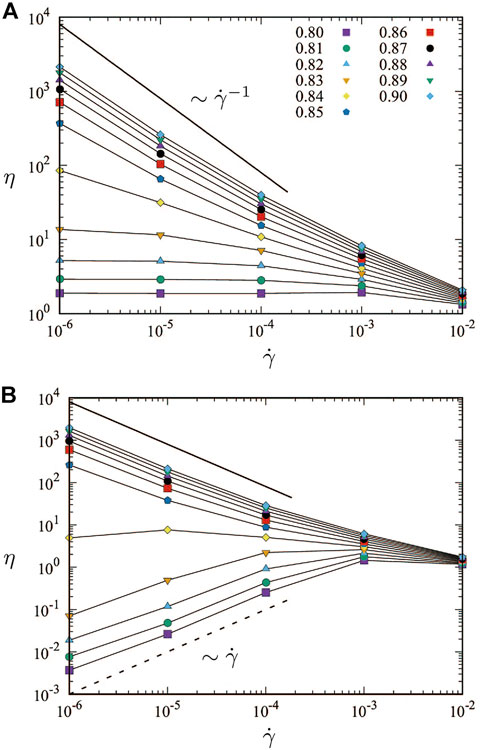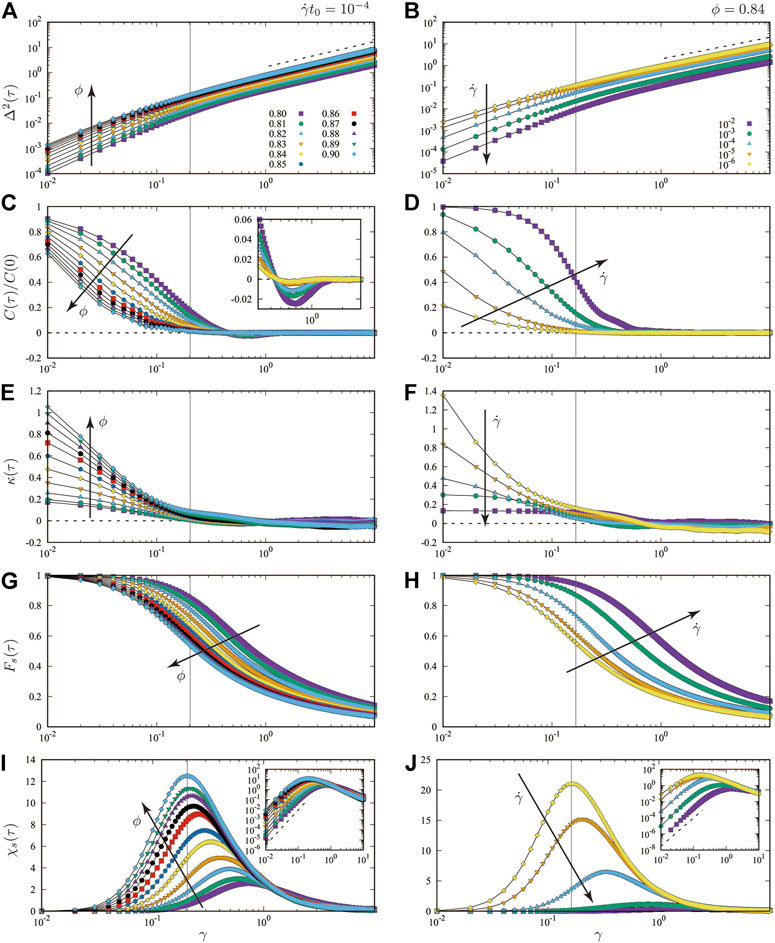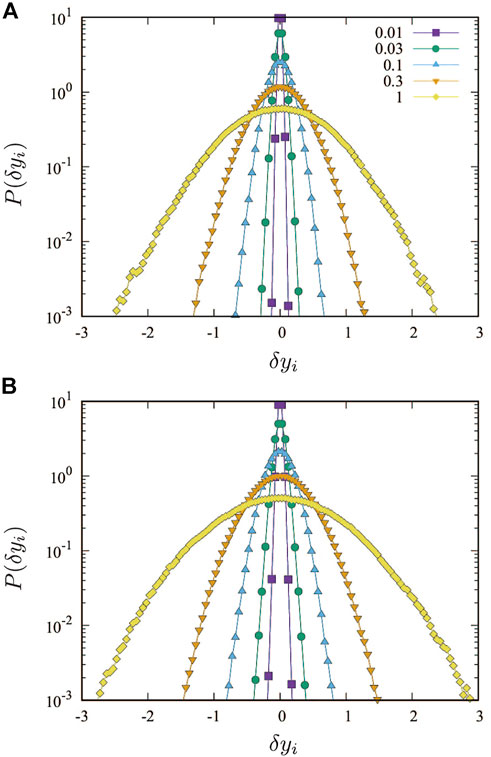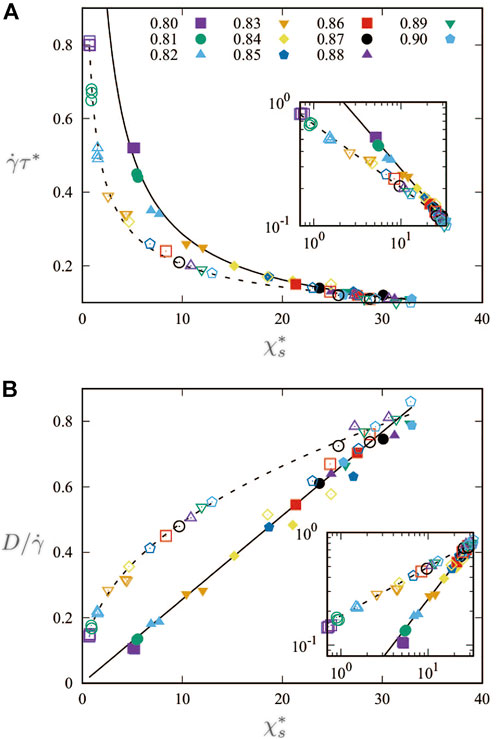- 1Department of Physics, Faculty of Science, Kyoto Sangyo University, Kyoto, Japan
- 2Department of Physics, Nagoya University, Nagoya, Japan
We study two-dimensional dense granular flows by molecular dynamics simulations. We quantify shear-induced diffusion of granular particles by the transverse component of particle displacements. In long time scales, the transverse displacements are described as normal diffusion and obey Gaussian distributions, where time correlations of particle velocities entirely vanish. In short time scales, the transverse displacements are strongly non-Gaussian if the system is dense and sheared quasistatically though memory effects on the particle velocities are further suppressed. We also analyze spatio-temporal structures of the transverse displacements by self-intermediate scattering functions and dynamic susceptibilities. We find that the relation between the maximum intensity and characteristic time scale for dynamic heterogeneities is dependent on the models of contact damping (which exhibit different rheological properties such as the Newtonian fluids’ behavior and shear thickening). In addition, the diffusion coefficient over the shear rate is linear (sub-linear) in the maximum of dynamic susceptibility if the damping force is not restricted (restricted) to the normal direction between the particles in contact.
1 Introduction
Flows of granular materials are of great importance to engineering technology [1, 2] and a better understanding of their transport phenomena is crucial to many industrial processes such as mixing and segregation [3]. Because constituent grains are macroscopic in size, e.g., are typically from few μm to mm in diameter [4], thermal fluctuations do not play a role in flows and transport phenomena of granular materials. This means that granular flows are induced only by external forces and “mechanically driven” particle motions have extensively been studied by experiments [5–12] and numerical simulations [13–19]. It now seems to be a common consensus that collective motions of granular particles are more pronounced as the system approaches the jamming transition [20].
In recent years, diffusion of the particles under shear, i.e. shear-induced diffusion, has widely been investigated by experiments [21–25] and molecular dynamics (MD) simulations [26–31]. From a scaling argument, the shear-induced diffusion coefficient scales as
The collective motions of the particles enhance self-diffusion and thus the scaling argument was revised as
In addition to the shear-induced diffusion, analogies with dynamic heterogeneities [33, 34] have also been made by experiments [9, 10] and numerical simulations [15–17]. Associating the mechanical driving with thermal fluctuations, the physicists have analyzed heterogeneous nature of particle motions both in space and time. Then, a link between the shear-induced diffusion and dynamic heterogeneities was suggested as
In this paper, we study the shear-induced diffusion and dynamic heterogeneities in dense granular flows by MD simulations. We investigate wide ranges of control parameters, i.e. the packing fraction of the particles ϕ and shear rate
2 Method
We study dense granular flows in two dimensions by MD simulations. To avoid crystallization of the system, we randomly distribute a 50 : 50 binary mixture of N = 2048 particles in a L × L square periodic box. Different kinds of particles have the same mass m and different diameters, dS and dL = 1.4dS [20, 37]. Repulsive force between the particles, i and j, in contact is modeled as elastic force,
We simulate simple shear flows of the system under the Lees-Edwards boundary condition. In each time step, every particle position ri = (xi, yi) is replaced with (xi + Δγyi, yi) (i = 1, …, N) and then equations of motion,
3 Results
In this section, we show our numerical results of shear-induced diffusion and dynamic heterogeneities in dense granular flows. We clarify the role of packing fraction of the particles ϕ and shear rate

FIGURE 1. Double logarithmic plots of the shear viscosity η and shear rate
Since our system is homogeneously sheared along the x-direction, we analyze fluctuating transverse motions of the particles along the y-direction. We introduce a transverse displacement of the particle i (= 1, …, N) as the time integral,
where τ is a time interval and viy(t) is the y-component of particle velocity [42]. Note that the initial time ta can arbitrary be chosen during a steady state.
In the following, we associate the fluctuating transverse motions of the particles (Eq. 1) with thermally activated molecular motions in glasses [33]. We show how the shear-induced diffusion is controlled by the parameters, ϕ and
3.1 Shear-induced diffusion
We quantify shear-induced diffusion of the particles by the transverse component of mean squared displacement (MSD) [42],
where the ensemble average

FIGURE 2. The MSD Δ2(τ) ((A) and (B)), normalized VACF C(τ)/C(0) ((C) and (D)), non-Gaussian parameter κ(τ) ((E) and (F)), self-intermediate scattering function Fs(τ) ((G) and (H)), and dynamic susceptibility χs(τ) ((I) and (J)) as functions of the shear strain
We also analyze time correlations of transverse motions by the velocity auto-correlation function (VACF),
Figures 2C,D show the normalized VACFs, C(τ)/C(0), where ϕ and
The probability distribution function (PDF) of particle displacements is associated with the self-van Hove function which is another important measure of diffusion [43]. Figure 3 shows our numerical results of the PDFs of transverse displacements, P(δyi(τ)), where the models (A) A and (B) B are used for the contact damping. In this figure, each PDF has been averaged over 102 samples. As can be seen, the PDFs are quite insensitive to the models and are symmetric around δyi(τ) = 0, indicating that the anisotropy is negligible in our systems [44].

FIGURE 3. Semi-logarithmic plots of the PDFs of transverse displacements δyi(τ) (i = 1, …, N), where the models (A) A and (B) B are used for the damping force. The shear strain increases from
The width (variance) of the PDF is equivalent to the MSD, while the shape of the PDF is characterized by the non-Gaussian parameter,
The non-Gaussian parameter is defined as the kurtosis subtracted by three, which quantifies how the PDF deviates from the normal distribution (where κ(τ) = 0). Figures 2E,F display the time development of non-Gaussian parameters, κ(τ), where the control parameters change as in Figures 2A,B. In this figure, we used the model A for the damping force (see SM [41] for the results of model B). The non-Gaussian parameters converge to zero if the strain exceeds the cross-over strain, γ > γc, regardless of ϕ and
3.2 Dynamic heterogeneities
Next, we examine dynamic heterogeneities of transverse motions of the particles. To quantify the dynamics of single particles, we introduce the self-intermediate scattering function as
with the wave number, k = 2π/d0. Figures 2G,H show the time development of self-intermediate scattering functions, Fs(τ), where the parameters, ϕ and
To further investigate spatio-temporal heterogeneous structures of transverse motions, we calculate the dynamic susceptibility as the variance of the function
Figures 2I,J display the time development of dynamic susceptibilities, χs(τ), where the control parameters change as in Figures 2A,B (see SM [41] for the results of model B). As in the case of glass forming liquids [34], χs(τ) has a single peak at a characteristic time scale, τ*. The height of the peak,
3.3 Dynamic criticality
In the case of glass forming liquids and homogeneously driven granular materials, both the peak height
In our MD simulations, however, we find that

FIGURE 4. (A) The peak position of dynamic susceptibility,
3.4 Shear-induced diffusion coefficient
It had been suggested by the elastoplastic model [35] that the diffusion coefficient of sheared athermal system is linked to the peak height of dynamic susceptibility as
We examine this linear scaling relation between D and
4 Discussion
In this study, we have numerically investigated shear-induced diffusion and dynamic heterogeneities in two-dimensional dense granular flows. Applying simple shear deformations to the system, we analyzed fluctuating transverse motions of the particles, where we focused on the role of packing fraction of the particles ϕ and shear rate
Though we have examined two different models of contact damping, where they exhibit the Newtonian fluids’ behavior and Bagnold scaling for sufficiently small ϕ and
5 Conclusion
In conclusion, we found that shear-induced transverse motions of granular particles are totally different from thermally activated molecular motions in glasses. The scaling relations between the maximum intensity of dynamic heterogeneities, characteristic time scale, and diffusion coefficient of the particles were confirmed in quasi-static flows, where the scaling exponents are dependent on the model of contact damping.
Data availability statement
The raw data supporting the conclusion of this article will be made available by the authors, without undue reservation.
Author contributions
KS and TK designed the research and wrote the article. KS performed the research.
Funding
This work was supported by KAKENHI Grant Nos. 20H01868, 21H01006, 22K03459, JPMJFR212T, 20H05157, 20H00128, 19K03767, 18H01188 from JSPS.
Conflict of interest
The authors declare that the research was conducted in the absence of any commercial or financial relationships that could be construed as a potential conflict of interest.
Publisher’s note
All claims expressed in this article are solely those of the authors and do not necessarily represent those of their affiliated organizations, or those of the publisher, the editors and the reviewers. Any product that may be evaluated in this article, or claim that may be made by its manufacturer, is not guaranteed or endorsed by the publisher.
Supplementary material
The Supplementary Material for this article can be found online at: https://www.frontiersin.org/articles/10.3389/fphy.2022.992239/full#supplementary-material
References
1. Jeager H, Nagel S, Behringer R. Granular solids, liquids, and gases. Rev Mod Phys (1996) 68:1259. doi:10.1103/RevModPhys.68.1259
2. Bonn D, Denn MM, Berthier L, Divoux T, Manneville S. Yield stress materials in soft condensed matter. Rev Mod Phys (2017) 89:035005. doi:10.1103/revmodphys.89.035005
3. Aranson IS, Tsimring LS. Patterns and collective behavior in granular media: Theoretical concepts. Rev Mod Phys (2006) 78:641–92. doi:10.1103/revmodphys.78.641
4. Castellanos A. The relationship between attractive interparticle forces and bulk behaviour in dry and uncharged fine powders. Adv Phys X (2005) 54:263–376. doi:10.1080/17461390500402657
5. Pouliquen O. Velocity correlations in dense granular flows. Phys Rev Lett (2004) 93:248001. doi:10.1103/physrevlett.93.248001
6. Dauchot O, Marty G, Biroli G. Dynamical heterogeneity close to the jamming transition in a sheared granular material. Phys Rev Lett (2005) 95:265701. doi:10.1103/physrevlett.95.265701
7. Keys AS, Abate AR, Glotzer SC, Durian DJ. Measurement of growing dynamical length scales and prediction of the jamming transition in a granular material. Nat Phys (2007) 3:260–4. doi:10.1038/nphys572
8. Candelier R, Dauchot O, Biroli G. Building blocks of dynamical heterogeneities in dense granular media. Phys Rev Lett (2009) 102:088001. doi:10.1103/physrevlett.102.088001
9. Katsuragi H, Abate AR, Durian DJ. Jamming and growth of dynamical heterogeneities versus depth for granular heap flow. Soft Matter (2010) 6:3023. doi:10.1039/b918991b
10. Nordstrom KN, Gollub JP, Durian DJ. Dynamical heterogeneity in soft-particle suspensions under shear. Phys Rev E (2011) 84:021403. doi:10.1103/physreve.84.021403
11. Rahmani Y, van der Vaart K, van Dam B, Hu Z, Chikkadi V, Schall P. Dynamic heterogeneity in hard and soft sphere colloidal glasses. Soft Matter (2012) 8:4264. doi:10.1039/c2sm25267h
12. Sanlí C, Saitoh K, Luding S, van der Meer D. Collective motion of macroscopic spheres floating on capillary ripples: Dynamic heterogeneity and dynamic criticality. Phys Rev E (2014) 90:033018. doi:10.1103/physreve.90.033018
13. Heussinger C, Barrat JL. Jamming transition as probed by quasistatic shear flow. Phys Rev Lett (2009) 102:218303. doi:10.1103/physrevlett.102.218303
14. Vågberg D, Olsson P, Teitel S. Universality of jamming criticality in overdamped shear-driven frictionless disks. Phys Rev Lett (2014) 113:148002. doi:10.1103/physrevlett.113.148002
15. Tsamados M. Plasticity and dynamical heterogeneity in driven glassy materials. Eur Phys J E (2010) 32:165–81. doi:10.1140/epje/i2010-10609-0
16. Hatano T. Rheology and dynamical heterogeneity in frictionless beads at jamming density. J Phys : Conf Ser (2011) 319:012011. doi:10.1088/1742-6596/319/1/012011
17. Heussinger C, Berthier L, Barrat JL. Superdiffusive, heterogeneous, and collective particle motion near the fluid-solid transition in athermal disordered materials. Eur Phys Lett (2010) 90:20005. doi:10.1209/0295-5075/90/20005
18. Goldenberg C, Tanguy A, Barrat JL. Particle displacements in the elastic deformation of amorphous materials: Local fluctuations vs. non-affine field. Europhys Lett (2007) 80:16003. doi:10.1209/0295-5075/80/16003
19. Saitoh K, Mizuno H. Anomalous energy cascades in dense granular materials yielding under simple shear deformations. Soft Matter (2016) 12:1360–7. doi:10.1039/c5sm02760h
20. Olsson P, Teitel S. Critical scaling of shear viscosity at the jamming transition. Phys Rev Lett (2007) 99:178001. doi:10.1103/physrevlett.99.178001
21. Geng J, Behringer RP. Diffusion and mobility in a stirred dense granular material. Phys Rev Lett (2004) 93:238002. doi:10.1103/physrevlett.93.238002
22. Eisenmann C, Kim C, Mattsson J, Weitz DA. Shear melting of a colloidal glass. Phys Rev Lett (2010) 104:035502. doi:10.1103/physrevlett.104.035502
23. Wandersman E, Dijksman JA, van Hecke M. Particle diffusion in slow granular bulk flows. Eur Phys Lett (2012) 100:38006. doi:10.1209/0295-5075/100/38006
24. Besseling R, Weeks ER, Schofield AB, Poon WCK. Three-dimensional imaging of colloidal glasses under steady shear. Phys Rev Lett (2007) 99:028301. doi:10.1103/physrevlett.99.028301
25. Möbius ME, Katgert G, van Hecke M. Relaxation and flow in linearly sheared two-dimensional foams. Eur Phys Lett (2010) 90:44003. doi:10.1209/0295-5075/90/44003
26. Ono IK, Tewari S, Langer SA, Liu AJ. Velocity fluctuations in a steadily sheared model foam. Phys Rev E (2003) 67:061503. doi:10.1103/physreve.67.061503
27. Olsson P. Diffusion and velocity autocorrelation at the jamming transition. Phys Rev E (2010) 81:040301(R). doi:10.1103/physreve.81.040301
28. Kharel P, Rognon P. Vortices enhance diffusion in dense granular flows. Phys Rev Lett (2017) 119:178001. doi:10.1103/physrevlett.119.178001
29. Lemaitre A, Caroli C. Rate-dependent avalanche size in athermally sheared amorphous solids. Phys Rev Lett (2009) 103:065501. doi:10.1103/physrevlett.103.065501
30. Clemmer JT, Salerno KM, Robbins MO. Criticality in sheared, disordered solids. II. Correlations in avalanche dynamics. Phys Rev E (2021) 103:042606. doi:10.1103/physreve.103.042606
31. Cai R, Xiao H, Zheng J, Zhao Y. Diffusion of size bidisperse spheres in dense granular shear flow. Phys Rev E (2019) 99:032902. doi:10.1103/physreve.99.032902
32. Heussinger C, Barrat JL. Jamming transition as probed by quasistatic shear flow. Phys Rev Lett (2009) 102:218303. doi:10.1103/physrevlett.102.218303
33. Berthier L, Biroli G. Theoretical perspective on the glass transition and amorphous materials. Rev Mod Phys (2011) 83:587–645. doi:10.1103/revmodphys.83.587
34. Berthier L. Dynamic heterogeneity in amorphous materials. Physics (2011) 4:42. doi:10.1103/physics.4.42
35. Martens K, Bocquet L, Barrat JL. Connecting diffusion and dynamical heterogeneities in actively deformed amorphous systems. Phys Rev Lett (2011) 106:156001. doi:10.1103/physrevlett.106.156001
36. Lechenault F, Dauchot O, Biroli G, Bouchaud JP. Lower bound on the four-point dynamical susceptibility: Direct experimental test on a granular packing. Europhys Lett (2008) 83:46002. doi:10.1209/0295-5075/83/46002
37. Saitoh K, Hatano T, Ikeda A, Tighe BP. Stress relaxation above and below the jamming transition. Phys Rev Lett (2020) 124:118001. doi:10.1103/physrevlett.124.118001
38. Vågberg D, Olsson P, Teitel S. Dissipation and rheology of sheared soft-core frictionless disks below jamming. Phys Rev Lett (2014) 112:208303. doi:10.1103/physrevlett.112.208303
39. Luding S. Anisotropy in cohesive, frictional granular media. J Phys : Condens Matter (2005) 17:S2623–40. doi:10.1088/0953-8984/17/24/017
42. Saitoh K, Kawasaki T. Critical scaling of diffusion coefficients and size of rigid clusters of soft athermal particles under shear. Front Phys (2020) 8:99. doi:10.3389/fphy.2020.00099
44. Saitoh K, Mizuno H. Anisotropic decay of the energy spectrum in two-dimensional dense granular flows. Phys Rev E (2017) 96:012903. doi:10.1103/physreve.96.012903
45. Chaudhuri P, Berthier L, Kob W. Universal nature of particle displacements close to glass and jamming transitions. Phys Rev Lett (2007) 99:060604. doi:10.1103/physrevlett.99.060604
46. Kawasaki T, Onuki A. Slow relaxations and stringlike jump motions in fragile glass-forming liquids: Breakdown of the Stokes-Einstein relation. Phys Rev E (2013) 87:012312. doi:10.1103/physreve.87.012312
47. Kawasaki T, Kim K. Identifying time scales for violation/preservation of Stokes-Einstein relation in supercooled water. Sci Adv (2017) 3:e1700399. doi:10.1126/sciadv.1700399
48. Lačević N, Starr FW, Schrøder TB, Glotzer SC. Spatially heterogeneous dynamics investigated via a time-dependent four-point density correlation function. J Chem Phys (2003) 119:7372–87. doi:10.1063/1.1605094
49. Andreotti B, Barrat JL, Heussinger C. Shear flow of non-brownian suspensions close to jamming. Phys Rev Lett (2012) 109:105901. doi:10.1103/physrevlett.109.105901
50. Kawasaki T, Ikeda A, Berthier L. Thinning or thickening? Multiple rheological regimes in dense suspensions of soft particles. Eur Phys Lett (2014) 107:28009. doi:10.1209/0295-5075/107/28009
51. Otsuki M, Hayakawa H. Critical scaling near jamming transition for frictional granular particles. Phys Rev E (2011) 83:051301. doi:10.1103/physreve.83.051301
52. Seto R, Mari R, Morris JF, Denn MM. Discontinuous shear thickening of frictional hard-sphere suspensions. Phys Rev Lett (2013) 111:218301. doi:10.1103/physrevlett.111.218301
53. Irani E, Chaudhuri P, Heussinger C. Impact of attractive interactions on the rheology of dense athermal particles. Phys Rev Lett (2014) 112:188303. doi:10.1103/physrevlett.112.188303
54. Marschall T, Keta YE, Olsson P, Teitel S. Orientational ordering in athermally sheared, aspherical, frictionless particles. Phys Rev Lett (2019) 122:188002. doi:10.1103/physrevlett.122.188002
55. Oyama N, Mizuno H, Saitoh K. Avalanche interpretation of the power-law energy spectrum in three-dimensional dense granular flow. Phys Rev Lett (2019) 122:188004. doi:10.1103/physrevlett.122.188004
Keywords: diffusion, dynamic heterogeneities, granular flow, jamming transition, rheology
Citation: Saitoh K and Kawasaki T (2022) Shear-induced diffusion and dynamic heterogeneities in dense granular flows. Front. Phys. 10:992239. doi: 10.3389/fphy.2022.992239
Received: 12 July 2022; Accepted: 21 September 2022;
Published: 12 October 2022.
Edited by:
Ramon Planet, University of Barcelona, SpainReviewed by:
Rushi Kumar B, VIT University, IndiaPrasenjit Das, Indian Institute of Science Education and Research Mohali, India
Copyright © 2022 Saitoh and Kawasaki. This is an open-access article distributed under the terms of the Creative Commons Attribution License (CC BY). The use, distribution or reproduction in other forums is permitted, provided the original author(s) and the copyright owner(s) are credited and that the original publication in this journal is cited, in accordance with accepted academic practice. No use, distribution or reproduction is permitted which does not comply with these terms.
*Correspondence: Kuniyasu Saitoh, ay5zYWl0b2hAY2Mua3lvdG8tc3UuYWMuanA=
 Kuniyasu Saitoh
Kuniyasu Saitoh Takeshi Kawasaki
Takeshi Kawasaki